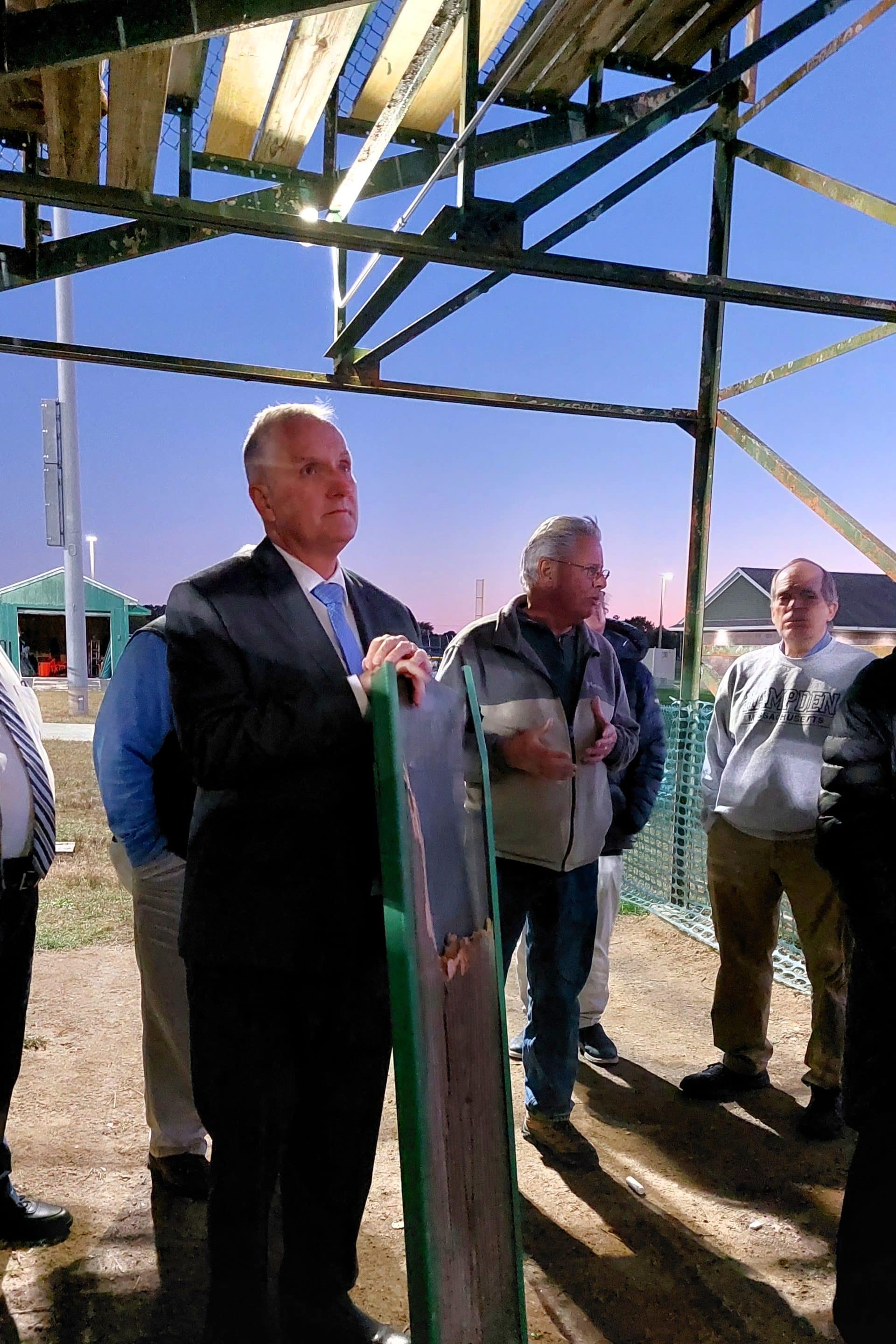Hampden-Wilbraham Regional School District Superintendent John Provost shows the School Committee and town officials a bleacher seat board that broke under a person’s weight the day before.
Reminder Publishing photo by Sarah Heinonen
WILBRAHAM — The Hampden-Wilbraham Regional School District School Committee hosted the leadership from Hampden and Wilbraham for a multi-board meeting that varied in tone from tense to cautiously optimistic.
The meeting began with a field trip to the bleachers, during which the board and committee members walked under the structure while a game was happening, and fans were in the stands.
Superintendent John Provost showed the elected officials a board, covered in a plasticized coating, that had snapped in half the day before. “This happens all the time,” Provost said. Hampden Advisory member Heather Turcotte later commented that it looked like the boards were staged because they had been left next to the bleachers.
School Committee member Michael Tirabassi pointed out the 18-inch gaps between the seats and floorboards, warning that a toddler could fit through and fall 20 feet to the ground. Wilbraham Finance Committee Chair Todd Schneider interjected, “You always go to someone’s going to die. Can you not do that?” He added that no one had fallen through the slats since the bleachers were built in the 1950s. However, at the School Committee’s Sept. 9 meeting, MRHS Principal Steven Hale said children regularly climb between the boards and down the structure’s metal frame, rather than wait to exit with the crowd.
While standing on the bleachers, a student told School Committee member Sean Kennedy, Matthews and Turcotte that he did not feel safe on the stands, and that they swayed under the weight of fans. Matthews told him, “If you don’t feel safe, don’t go up.”
Matthews and Turcotte repeatedly reminded Kennedy and School Committee member Tim Collins that Wilbraham Building Inspector John Walsh had examined the bleachers and found them to be “structurally sound,” needing only board replacement and routine maintenance.
At the Sept. 9 meeting, Facilities and Maintenance Manager David Rogers said cracked or broken bleacher boards were replaced each summer and as needed throughout the year. In the 2024-25 school year, the district spent $4,719 on boards and hardware. The estimate did not include work hours spent on the repairs.
“They may be structurally sound but that doesn’t make them safe,” Collins responded. He explained that, because of their age, they are not up to code. Collins warned that if there was a “catastrophic accident,” the liability to the district could outweigh the cost of replacement.
Matthews urged the School Committee to have three “engineering solutions” for repairing the bleachers drawn up. Tirabassi said that if the cost of repairs exceeds 30% of the bleachers’ value, the district would legally be required to bring them up to code and into compliance with the Americans with Disabilities Act. However, Wilbraham Select Board member Susan Bunnell questioned whether that requirement applied to the bleachers or only to buildings.
Provost explained that he had asked for value estimates from three different sources. Two said they do not assess such structures, and one told him, “Their true value was the scrap metal.”
When Hampden Advisory Chair Doug Boyd asked if the bleachers were considered for replacement when the school was rebuilt in 2010. Hale, who was the principal at the time, said it had been considered but was eliminated to save costs and make the project more likely to pass at Town Meeting.
The district’s list of capital requests in fiscal year 2026 totaled $10.9 million, Wilbraham Select Board member Marc Ducey said, adding that it would be “irresponsible” to not consider the bleachers as a single project.
Provost said many of the items on the capital list were deferred from previous years. “We’ve got to figure out a way to get out of that,” he said. “You know, if we just keep kicking things down the road, the number gets bigger every year until it becomes insurmountable.”
Cooperation
Town and district leadership talked at length about the roots of division between them and the need to cooperate. Assistant Superintendent for Finance, Operations and Human Resources Douglas Slaughter said it was “critical” that the boards and the district meet and cooperate multiple times between the October start of the FY27 budget process and Town Meeting in May 2026.
But Schneider questioned whether the School Committee was interested in cooperation and cited guidance from the state Department of Elementary and Secondary Education that stated the budget assessment number voted by the School Committee must be presented to voters at Town Meeting. Schneider said this meant that the district was not required to work with the towns on an affordable budget.
In the past, Schneider said towns worked with the School Committee to identify a number that would fund the needs of the schools, while being affordable to the towns. Three years ago, that changed and since then, there have been last-minute negotiations down to the wire.
Kennedy responded that the breakdown in the budgeting norms occurred when the Finance Committee disapproved of expenses in the budget. “Suddenly,” he said, there were “line-item vetoes.”
Schneider countered that the Finance Committee raised $1.7 million for the district for FY26, adding, “We’re giving you every dollar we could.” To this, Tirabassi said the district is facing ever-increasing mandated costs, forcing the School Committee to make sacrifices every year. “Our arms are twisted behind our backs,” he said.
The board discussed whether capital items should be included in the assessment, with the operating budget and debt service. Slaughter said that legally, the assessment is structured to include all three parts. If the towns prefer, they can be presented to the capital items as a separate article on the annual Town Meeting warrant. Wilbraham Select Board Chair Michael Squindo clarified that if the capital items do not pass, the entire assessment is defeated, and the School Committee must reconsider the budget.
Hampden Selectboard Chair John Flynn said the capital budget “fluctuates wildly” from year to year, making it difficult for the towns to plan for. Slaughter said the purpose of the district’s capital plan was to allow the towns to see what projects are expected over the next several years and which ones are priorities. Provost emphasized the need to work with the towns’ capital planning committees, which handle municipal capital projects in the same manner.
All sides wanted to see such collaboration on the capital items and assessment as they move into the budget season.



